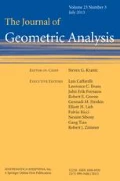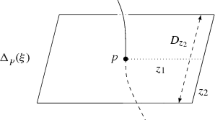Abstract
We prove the existence of complete cohomogeneity one triaxial Kähler–Einstein metrics in dimension four under an action of the Euclidean group E(2). We also demonstrate local existence of Ricci flat Kähler metrics of a related type that are given via generalized PDEs, and determine, under mild conditions, whether they are complete. The common framework for both metric types is a frame-dependent system of Lie bracket relations and generalized PDEs yielding a class of Kähler–Einstein metrics on 4-manifolds which includes all diagonal Bianchi type A metrics.
Similar content being viewed by others
References
Aazami, A.B., Maschler, G.: Kähler metrics via Lorentzian geometry in dimension four. Complex Manifolds 7, 36–61 (2020)
Aazami, A.B., Maschler, G.: Canonical Kähler metrics on classes of Lorentzian 4-manifolds. Ann. Global Anal. Geom. 57, 175–204 (2020)
Belinskii, V.A., Gibbons, G.W., Page, D.N., Pope, C.N.: Asymptotically Euclidean Bianchi IX metrics in quantum gravity. Phys. Lett. 76B, 433–435 (1978)
de la Parra, A.B., Dancer, A.S., Wang, M.Y.: A Hamiltonian approach to the cohomogeneity one Ricci soliton equations and explicit examples of non-Kähler solitons. J. Math. Phys. 57, 122501 (2016)
Böhm, C.: Non-compact cohomogeneity one Einstein manifolds. Bull. Soc. Math. France 127, 135–177 (1999)
Cecchini, S.: A note on the Gaussian curvature on noncompact surfaces. arXiv:1609.07631
Dancer, A.S., Hall, S.J., Wang, M.Y.: Cohomogeneity one shrinking Ricci solitons: an analytic and numerical study. Asian J. Math. 17, 33–61 (2013)
Dancer, A.S., Strachan, I.A.B.: Kähler–Einstein metrics with SU(2) action. Math. Proc. Camb. Philos. Soc. 115, 513–525 (1994)
Dancer, A.S., Strachan, I.A.B.: Cohomogeneity-one Kähler metrics. Twistor theory (Plymouth), pp. 9–27. Lecture Notes in Pure and Appl. Mathematics 169. Dekker, New York (1995)
Dancer, A.S., Wang, M.Y.: Kähler–Einstein metrics of cohomogeneity one. Math. Ann. 312, 503–526 (1998)
Dancer, A.S., Wang, M.Y.: On Ricci solitons of cohomogeneity one. Ann. Glob. Anal. Geom. 39, 259–292 (2011)
Derdzinski, A., Maschler, G.: Local classification of conformally-Einstein Kähler metrics in higher dimensions. Proc. Lond. Math. Soc. 87, 779–819 (2003)
Leitner, F.: Examples of almost Einstein structures on products and in cohomogeneity one. Differ. Geom. Appl. 29, 440–462 (2011)
O’Neill, B.: Semi-Riemannian Geometry. With Applications to Relativity. Pure and Applied Mathematics, vol. 103. Academic Press, New York (1983)
Pedersen, H.: Eguchi–Hanson metrics with cosmological constant. Class. Quant. Gravity 2, 579–587 (1985)
Petersen, P.: Riemannian Geometry. Graduate Texts in Mathematics, vol. 171, 3rd edn. Springer, Cham (2016)
Verdiani, L., Ziller, W.: smoothness conditions in cohomogeneity one manifolds. arXiv:1804.04680
Wink, M.: Cohomogeneity one Ricci Solitons from Hopf Fibrations. arXiv:1706.09712
Yau, S.T.: Some function-theoretic properties of complete Riemannian manifold and their applications to geometry. Indiana Univ. Math. J. 25, 659–670 (1976)
Author information
Authors and Affiliations
Corresponding author
Additional information
Publisher's Note
Springer Nature remains neutral with regard to jurisdictional claims in published maps and institutional affiliations.
Appendix A: Outline of the Derivation of the ODE and PDE Systems
Appendix A: Outline of the Derivation of the ODE and PDE Systems
1.1 Appendix A.1. Generalized PDEs
Suppose one is given a 4-manifold with a frame \(\mathbf{k}\), \(\mathbf{t}\), \(\mathbf{x}\), \(\mathbf{y}\) satisfying the Lie bracket relations (3)–(5) for functions A, B, C, D, E, F, G, H, L, N on the frame domain. The dual coframe \({\hat{\mathbf{k}}}\), \({\hat{\mathbf{t}}}\), \({\hat{\mathbf{x}}}\), \({\hat{\mathbf{y}}}\) then satisfies
The vanishing of \(\mathrm{d}^2\) on the coframe 1-forms gives four equations, two of which are identical. Writing, for example, \(\mathrm{d}N=\mathrm{d}_\mathbf{k}N{\hat{\mathbf{k}}}+\mathrm{d}_\mathbf{t}N{\hat{\mathbf{t}}}+\mathrm{d}_\mathbf{x}N{\hat{\mathbf{x}}}+\mathrm{d}_\mathbf{y}N{\hat{\mathbf{y}}}\) etc. and separating components yields 12 scalar equations
Adding and subtracting the two equations (61), the two equations (62) and (65) and the two equations (63)–(64), while using relations (6)–(7), yields six equations of which only five are independent. The resulting equivalent system is
Assume now that M admits a Kähler metric making our frame orthonormal, which is additionally Einstein. Then, in addition to the above system, the six equations (10) reproduced below also hold.
At this point our derivation splits into cases.
1.2 Appendix A.2: The Case \(\lambda \ne 0\)
If the Einstein constant \(\lambda \) is nonzero, then by (72)
In that case, (72), (74) and (75) clearly imply
Additionally, by the second of equations (3), we have the following basic fact: for any smooth function f on the frame domain,
Thus from (66) \(d_{\mathbf{k}+\mathbf{t}}L=0\). This, in conjunction with (66), (74), (75) and the basic fact imply in turn
Among these, the third and sixth equations imply
As we can substitute this in (73) we note the following: (72) implies both that N is nowhere vanishing, and that we can replace \(2L+C-H+A-F\) with \(-\lambda /N\). This then implies that the second equation in (68) yields (73). We can thus drop (73) from our system.
We now introduce the change of variables (12) valid at points of the frame domain where
and note its inverse.
Since
by (6)–(7), it follows from (78) and (77) that
Hence
where the above basic fact was also employed.
Next we show that the four equations (67) can be replaced by two equivalent equations in terms of R and S. On the one hand, by (82), \(\mathrm{d}_\mathbf{y}B=\mathrm{d}_\mathbf{y}(B+C)/2=\mathrm{d}_\mathbf{y}(R\sin S)/2\), \(\mathrm{d}_\mathbf{x}C=\mathrm{d}_\mathbf{x}(B+C)/2=\mathrm{d}_\mathbf{x}(R\sin S)/2\), \(\mathrm{d}_\mathbf{y}F=\mathrm{d}_\mathbf{y}(F+G)/2=\mathrm{d}_\mathbf{y}(R\cos S)/2\), \(\mathrm{d}_\mathbf{x}G=\mathrm{d}_\mathbf{x}(F+G)/2=\mathrm{d}_\mathbf{x}(R\cos S)/2\). On the other hand \(\mathrm{d}_\mathbf{y}A = \mathrm{d}_\mathbf{y}(R\cos S)/2\), \(\mathrm{d}_\mathbf{x}D = -\mathrm{d}_\mathbf{x}(R\cos S)/2\), \(\mathrm{d}_\mathbf{y}E = -\mathrm{d}_\mathbf{y}(R\sin S)/2\), \(\mathrm{d}_\mathbf{x}H = \mathrm{d}_\mathbf{x}(R\sin S)/2\), because (6)–(7) imply \(A=(N+F+G)/2\), \(D=(N-F-G)/2\), \(E=-(N+B+C)/2\), \(H=(-N+B+C)/2\). Thus (67) can be replaced by the two equations
Finally, Eqs. (69)–(71) are replaced by
The justification is straightforward, except for noting that the last two terms of (69) equal \(2(CF-GB)\), which, via (80), is calculated to equal \([R(P-Q)\sin S-R(P+Q)\cos S]/2\).
So far, we know that the \(d_\mathbf{x}\), \(d_\mathbf{y}\), \(d_{\mathbf{k}+\mathbf{t}}\) derivatives of L, N, P and Q vanish. Our goal now is to prove the same for R and S, and also find the \(d_{\mathbf{k}-\mathbf{t}}\) derivatives of all these quantities. Looking at (86), as \(d_{\mathbf{k}+\mathbf{t}}Q=0\), it becomes
Applying \(\mathrm{d}_\mathbf{x}\), \(\mathrm{d}_\mathbf{y}\), and \(\mathrm{d}_{\mathbf{k}+\mathbf{t}}\) to this equation, and employing the Lie bracket relations (3)–(5), we find that
Using this we see from (83) that, as \(R\ne 0\) under our assumptions, we have
Now (84)–(85) can be converted to the form
for certain expressions \(\alpha \), \(\beta \) which thus vanish. Their vanishing is equivalent to the equations
As \(d_{\mathbf{k}+\mathbf{t}}R=0\) and \(d_{\mathbf{k}+\mathbf{t}}S=0\), adding and subtracting these to the above gives
Now from (11) we have \(\mathrm{d}\tau ={\hat{\mathbf{k}}}-{\hat{\mathbf{t}}}\) in an open set V, and \(\mathrm{d}_{\mathbf{k}-\mathbf{t}}\tau =2\) due to the metric values on \(\mathbf{k}\) and \(\mathbf{t}\). Thus L, N, P, Q, R and S are functions of \(\tau \) in the sense of Sect. 6. Employing the abuse of notation described there, the second of equations (68) along with equations (87) and (89) show that ODEs in (13) hold for \(N'\), \(P'\), \(R'\) and \(S'\).
As N is nowhere vanishing, the only remaining independent equation is (72), which in the variables (12) is written, with the help of the definition of P and (6)–(7), in the form
However, differentiating (90) with respect to \(\tau \), then replacing \(N'\) by its expression from (13) and simplifying yields, as N is nowhere vanishing, the equation for \(L'\) in (13). This concludes the case \(\lambda \ne 0\).
1.3 Appendix A.3: The Case \(\lambda =0\), \(N=0\)
If \(\lambda =0\), by (72), at each point either (76) does not hold, or \(N=0\). We assume the latter everywhere:
Using (81), which still holds, when \(N=0\) equation (73) can be written in the form
Applying (71) and (12) gives (14)iii. Applying \(d_\mathbf{x}\) and \(d_\mathbf{y}\) to the latter and using (66) gives \(d_\mathbf{x}R=0\), \(d_\mathbf{y}R=0\). As the passage from (67) to (83) is still valid, the latter gives the vanishing of \(d_\mathbf{x}S\) and \(d_\mathbf{y}S\). As the \(d_\mathbf{x}\), \(d_\mathbf{y}\) parts of (78) still hold, they lead as before to the vanishing of the \(d_\mathbf{x}\) and \(d_\mathbf{y}\) derivatives of P and Q.
Of Eqs. (66)–(75), that always hold, the ones whose consequences have not yet been explored are (69)–(71), which translate in the variables (12) to (84)–(86). Of the latter equations, the first two translate as before to (88), and adding and subtracting these gives (14)i, ii. Whereas (86) is equivalent (14)iv.
After the rotation in \(\mathcal {H}\) that gives \(S=\pi /4\), the equations of (14) turn into those of (50). Conversely, on (M, g) with (3)–(7) and \(N=0\), starting from (50) or its general S form (14), along with the assumption on the vanishing of \(d_\mathbf{x}\) and \(d_\mathbf{y}\) on P, Q, R, S, L, one easily checks that the above steps are reversible and lead to equations (72)–(75) with \(\lambda =0\), i.e. to (10), so that the metric is Ricci flat.
Rights and permissions
About this article
Cite this article
Maschler, G., Ream, R. On the Completeness of Some Bianchi Type A and Related Kähler–Einstein Metrics. J Geom Anal 31, 8347–8384 (2021). https://doi.org/10.1007/s12220-020-00597-7
Received:
Accepted:
Published:
Issue Date:
DOI: https://doi.org/10.1007/s12220-020-00597-7



